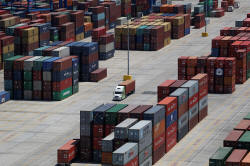China-U.S. container shipping rates sail past $20,000 to record
 Send a link to a friend
Send a link to a friend
 [August 05, 2021] By
Roslan Khasawneh and Muyu Xu [August 05, 2021] By
Roslan Khasawneh and Muyu Xu
SINGAPORE/BEIJING (Reuters) - Container
shipping rates from China to the United States have scaled fresh highs
above $20,000 per 40-foot box as rising retailer orders ahead of the
peak U.S. shopping season add strain to global supply chains.
The acceleration in Delta-variant COVID-19 outbreaks in several counties
has slowed global container turnaround rates.
Typhoons off China's busy southern coast in late July and this week have
also contributed to the crisis gripping the world's most important
method for moving everything from gym equipment and furniture to car
parts and electronics.
"These factors have turned global container shipping into a highly
disrupted, under-supplied sellerís market, in which shipping companies
can charge four to ten times the normal price to move cargoes," Philip
Damas, Managing Director at maritime consultancy firm Drewry, said.

"We have not seen this in shipping for more than 30 years," he said,
adding he expected the "extreme rates" to last until Chinese New Year in
2022.
RATE HIKES
The spot price per container on the China-U.S. East coast route - one of
the world's busiest container lanes - has climbed over 500% from a year
ago to $20,804 this week, freight-tracking firm Freightos said. That
compares to just under $11,000 on July 27.
The cost from China to the U.S. west coast is a little below $20,000,
while the latest China-Europe rate is nearly $14,000, Freightos' data
shows.
Ding Li, president of Chinaís port association, told Reuters the spike
followed a rebound in COVID-19 cases in other countries, which has
slowed turnover at some major foreign ports to around 7-8 days.
The surging container rates have fed through to higher charter rates for
container vessels, which has forced shipping firms to prioritise service
on the most lucrative routes.
[to top of second column] |

Shipping containers are stacked for storage at Wando Welch Terminal
operated by the South Carolina Ports Authority in Mount Pleasant,
South Carolina, U.S. May 10, 2018. Picture taken May 10, 2018.
REUTERS/Randall Hill

"Ships can only be profitably operated in the trades where freight rates
are higher, and that is why capacity is shifting mostly to the U.S.,"
said Tan Hua Joo, executive consultant at research consultancy
Alphaliner.
Some shippers have reduced volumes in less profitable routes, such as
the transatlantic and intra-Asia, said Damas.
"This means that rates on the latter are now increasing fast."
NO RESPITE
The rate surge is the latest reflection of disruptions since COVID-19
slammed the brakes on the global economy in early 2020 and triggered
huge changes to the flows of goods and healthcare equipment around the
world.
"Every time you think youíve come to an equilibrium, something happens
that allows shipping lines to increase the price," said Jason Chiang,
Director at Ocean Shipping Consultants, noting the Suez canal blockage
https://www.reuters.com/world/asia-pacific/how-giant-container-ship-is-blocking-suez-canal-2021-03-25
in March had played a major role in allowing firms to hike rates.
"There are new orders for shipping capacity, equal to almost 20% of
existing capacity, but they will only come online in 2023, so we will
not see any serious increase in supply for two years," Chiang added.
(Reporting by Roslan Khasawneh in Singapore and Muyu Xu in Beijing.
Editing by Gavin Maguire and Barbara Lewis)
[© 2021 Thomson Reuters. All rights
reserved.] Copyright 2021 Reuters. All rights reserved. This material may not be published,
broadcast, rewritten or redistributed.
Thompson Reuters is solely responsible for this content.
 |